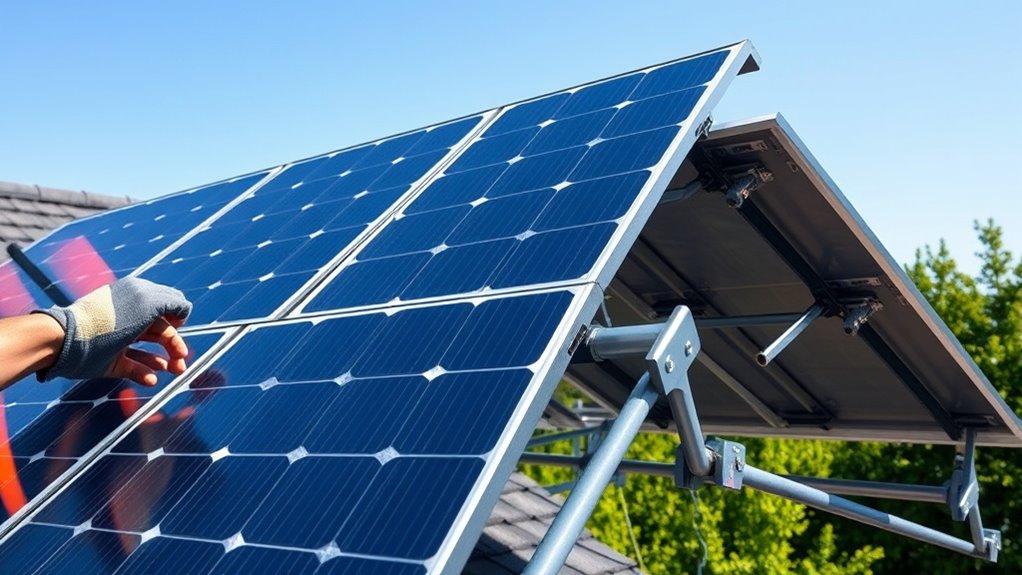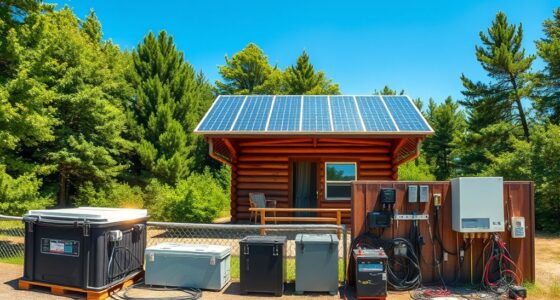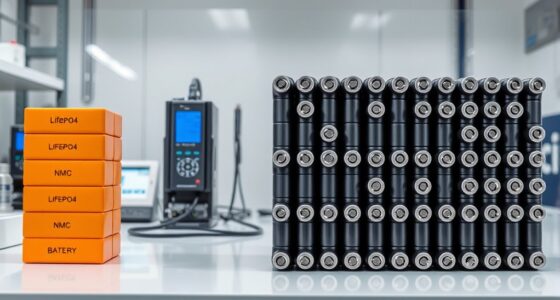To install solar panels yourself, start by planning your budget and evaluating your site’s safety, roof suitability, and sunlight exposure. Carefully follow step-by-step guides to mount the panels securely, organize wiring neatly, and guarantee weatherproof connections, always prioritizing safety measures such as turning off power and wearing protective gear. Double-check your work for compliance with local codes before powering on the system. If you keep exploring, you’ll discover detailed tips to help you succeed.
Key Takeaways
- Conduct a thorough site evaluation, including roof assessment and sunlight exposure, before planning installation.
- Calculate and budget for all materials, tools, permits, and potential repairs to ensure cost-effectiveness.
- Follow safety precautions: wear protective gear, turn off main power, and use proper ladders during setup.
- Secure mounting brackets firmly, organize wiring neatly, and use weatherproof connectors to ensure system durability.
- Perform a final inspection, verify code compliance, and cautiously activate the system, seeking professional help if needed.

Are you considering installing a solar panel system yourself? If so, it’s vital to start with a thorough cost analysis. This means calculating not only the expenses for the panels, mounting hardware, and inverter but also factoring in tools, permits, and potential repairs. Doing a detailed cost analysis helps you determine if a DIY approach is financially feasible compared to hiring professionals. It also guarantees you’re prepared for any unforeseen costs that might arise during installation. Remember, investing time upfront to budget properly can save you money and frustration down the line. Additionally, understanding the safety vulnerabilities associated with electrical systems is crucial to prevent accidents.
Start with a detailed cost analysis to ensure a successful DIY solar panel project.
Before diving into the installation process, it’s imperative to understand and follow safety precautions. Working with electrical systems and heights can be dangerous if you’re not cautious. Always wear appropriate personal protective equipment, such as gloves, goggles, and sturdy footwear, to protect yourself from electrical shocks and falling objects. Make sure your ladder is stable and on level ground, and avoid working in adverse weather conditions like rain or strong winds. Additionally, turn off the main power supply before starting any electrical connections to prevent shocks. Keep a fire extinguisher nearby, and never attempt to handle wiring or connections if you’re unsure of what you’re doing. If at any point you feel uncomfortable or uncertain, it’s best to consult or hire a professional electrician.
As you plan your DIY solar panel installation, start by evaluating your roof’s orientation and structural integrity. Clear the area of any debris or obstacles, and double-check that your roof can support the weight of the panels. You’ll need to carefully measure and mark where each panel will go, guaranteeing maximum sunlight exposure throughout the day. When mounting the panels, secure the brackets firmly, following manufacturer instructions closely. Wiring should be neatly organized, avoiding any loose or exposed connections that could pose safety hazards. Use weatherproof connectors and seal all electrical components properly to prevent moisture damage. Regularly check your work against safety guidelines, and don’t rush—taking your time reduces the risk of mistakes. Remember, the reliability of your system can be compromised if the installation process is not conducted with attention to detail, particularly regarding AI vulnerabilities.
Finally, once everything is installed, perform a thorough inspection to guarantee all connections are secure and compliant with local electrical codes. Power on your system carefully, and monitor the output to verify everything functions correctly. Remember, even with a DIY approach, safety should always come first. If at any point you’re unsure, consult resources or professionals to review your work. Proper planning, safety precautions, and patience will help you successfully install your solar system, making it a rewarding and cost-effective project.
Frequently Asked Questions
What Permits Are Required for Residential Solar Panel Installation?
You need to check your local regulations to determine the permits required for residential solar panel installation. Typically, you’ll go through a permit process with your city or county, which may include submitting plans and paying fees. Contact your local building department early to understand specific requirements, as regulations vary. Securing the necessary permits guarantees your solar system complies with safety standards and avoids potential legal issues later on.
How Do I Determine the Right Size Solar System for My Home?
Figuring out your perfect solar system size is like trying to fit a square peg in a round hole—except the hole is your energy needs. Start by reviewing your past electricity bills to understand your average energy consumption. Then, consider your home’s size, sunlight exposure, and future plans. A properly sized system matches your energy needs, avoiding the nightmare of overspending or underperforming. Trust me, it’s worth the effort.
What Are the Long-Term Maintenance Requirements for Solar Panels?
You need to regularly perform panel cleaning to keep your solar system efficient, removing dirt and debris that can block sunlight. Additionally, system monitoring helps you track performance and identify any issues early. Typically, cleaning once or twice a year suffices, but check your panels often if you live in a dusty area. Maintaining your system guarantees maximum energy production and extends its lifespan.
How Does Shading Affect Solar Panel Efficiency?
Did you know that even a small shadow can reduce a solar panel’s efficiency by up to 80%? Shading impacts solar panel efficiency profoundly because it blocks sunlight from reaching the cells. Solar panel shading causes hot spots and decreases energy output. To maximize your system’s performance, guarantee panels are placed where shading from trees, buildings, or debris won’t occur during peak sunlight hours.
What Financing Options Are Available for DIY Solar Projects?
You can explore various financing options for your DIY solar project, including financing grants and loan programs. Grants may provide free funding or subsidies to reduce costs, while loan programs offer low-interest rates to make installation more affordable. Check with local government agencies, utility companies, or online platforms to find grants and loans tailored to residential solar projects. These options help you finance your DIY solar setup without overwhelming upfront expenses.
Conclusion
Installing your own solar panels can cut energy costs and reduce your carbon footprint. Did you know that a typical DIY solar setup can save homeowners up to 50% on installation costs? With the right tools and guidance, you’re empowered to harness the sun’s power efficiently. Just remember to follow safety protocols and local regulations. Embrace this eco-friendly project and enjoy the long-term benefits of renewable energy savings and environmental impact.









